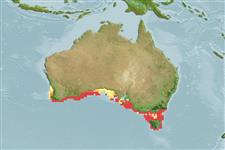>
Atheriniformes (Silversides) >
Atherinidae (Silversides) > Atherininae
Etymology: Kestratherina: Greek, kestra, -as = grey mullet +Greek, atherina, the Greek name for the eperlane; 1770 (Ref. 45335).
More on authors: Pavlov, Ivantsoff, Last & Crowley.
Environment: milieu / climate zone / depth range / distribution range
Écologie
marin; saumâtre démersal. Subtropical
Eastern Indian Ocean: southern Australia.
Taille / Poids / Âge
Maturity: Lm ? range ? - ? cm
Max length : 10.0 cm TL mâle / non sexé; (Ref. 9002)
Found mainly in sheltered coastal bays and clear marine estuaries (Ref. 9002). Also in schools in rocky, sandy vegetated areas (Ref. 9002).
Life cycle and mating behavior
Maturité | Reproduction | Frai | Œufs | Fécondité | Larves
Kuiter, R.H., 1993. Coastal fishes of south-eastern Australia. University of Hawaii Press. Honolulu, Hawaii. 437 p. (Ref. 9002)
Statut dans la liste rouge de l'IUCN (Ref. 130435: Version 2024-1)
Menace pour l'homme
Harmless
Utilisations par l'homme
Outils
Articles particuliers
Télécharger en XML
Sources Internet
Estimates based on models
Preferred temperature (Ref.
123201): 14 - 17.9, mean 15.4 °C (based on 54 cells).
Phylogenetic diversity index (Ref.
82804): PD
50 = 0.7500 [Uniqueness, from 0.5 = low to 2.0 = high].
Bayesian length-weight: a=0.01000 (0.00244 - 0.04107), b=3.04 (2.81 - 3.27), in cm total length, based on all LWR estimates for this body shape (Ref.
93245).
Niveau trophique (Ref.
69278): 3.3 ±0.4 se; based on size and trophs of closest relatives
Résilience (Ref.
120179): Haut, temps minimum de doublement de population inférieur à 15 mois (Preliminary K or Fecundity.).
Fishing Vulnerability (Ref.
59153): Low vulnerability (10 of 100).
